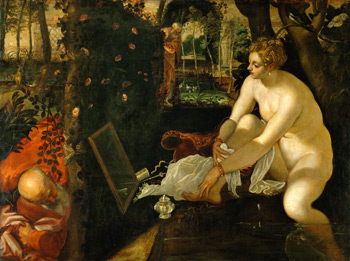Reflections and radiance: reverse interplays in painting
Venice is a city of reflections down to its painting. One of its celebrated artists—Giorgione—is said to have designed a picture that, through its interplay of reflections, asserted painting’s pre-eminence over sculpture. Indeed, to contemplate a sculpture, the viewer has to move around the work, whereas Giorgione’s painting—known only through the description of it provided by certain writers—afforded a simultaneous view of every angle of the human figure. It depicted the back view of a male nude; the front view was reflected in water from a spring and the two side views were revealed in a mirror and armor on either side of the composition.Reflections that reveal the other side of a picture disclose what is shielded from the viewer’s eye; this is notably true of Flemish painting, such as in Van Eyck. Though fascinated by the Flemish works, Italian artists used mirrors and reflections to channel the viewer’s gaze onto the subject. Thus they experimented in particular with the technical aspects of reflections—the composition’s “self-reflexivity,” foreshortened views in a mirror, or the way that light reflects off metallic objects.
Although Titian did use the Flemish-style convex mirror in his first painting of a woman at her toilet, flat mirrors prevailed among Italian artists. This type of mirror occurs in particular in the portraits of Susannah or Venus in which the woman, absorbed in studying her image, forgets that she is laying herself bare to the gaze of the viewer and those around her.
With its rounded surface, the polished steel of the armor may be reminiscent of the convex Flemish mirror. While some painters sought to experiment with this type of reflection and the processes of contraction and distortion it involved, art theoreticians were swift to expose the process as an easy option. Tintoretto alone would sometimes devote himself to the interplay of reflections on a breastplate, particularly by transforming the martial armor into a Venusian mirror, with female flesh blending into the burnished metal.
The evocative force of Venetian painting, conveyed through the atmospheric use of color, is an ill match with the painstakingly detailed image of a reflection in the Flemish style. Metal therefore reflects a diffuse effect of light and color, as well as revealing—particularly in Titian’s work—the ardor and military strength of the bearer. Items of gold and silver plate and glassware likewise bear witness to the importance of the theme of radiance, and of the reflection of light and color.







